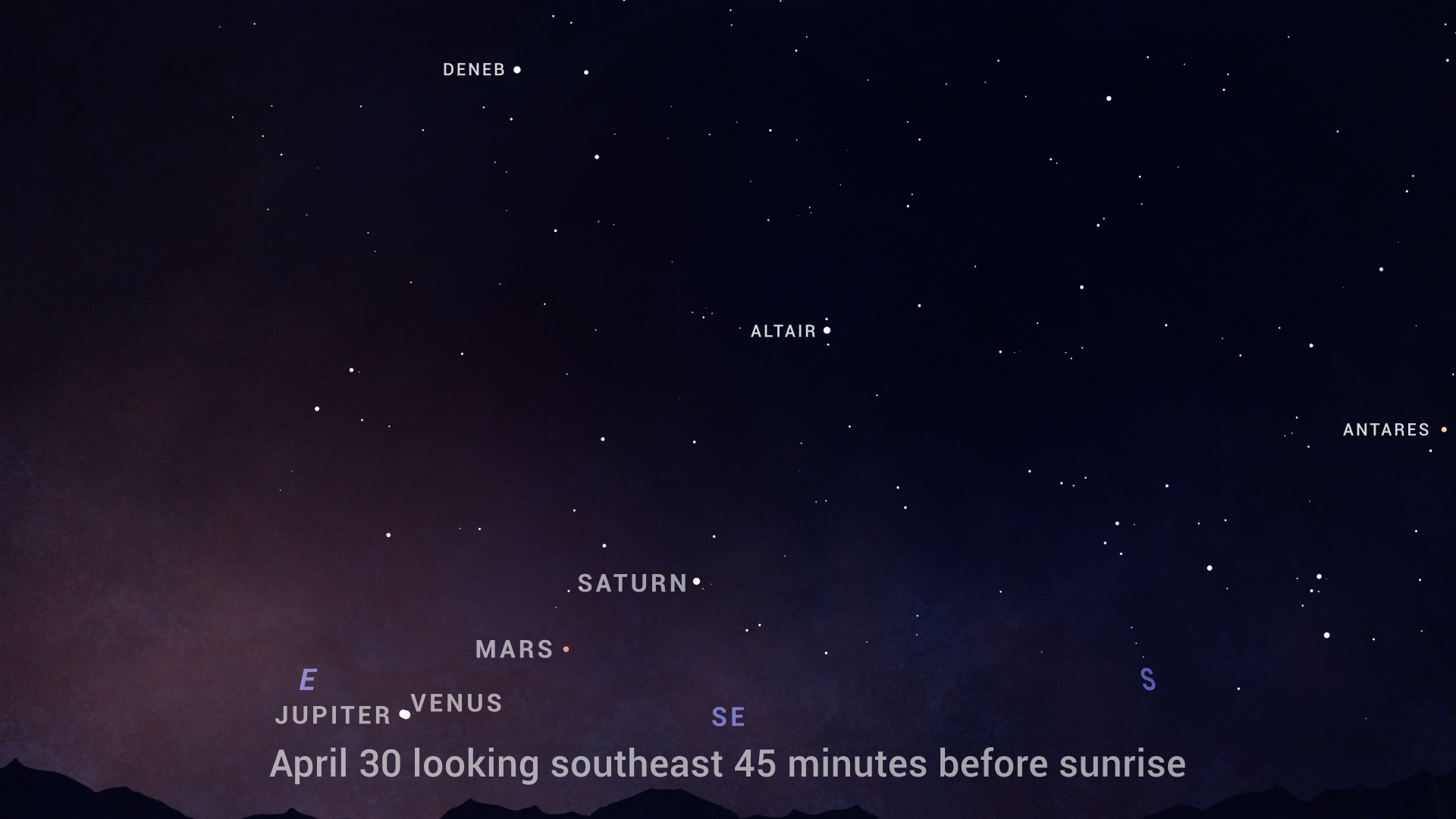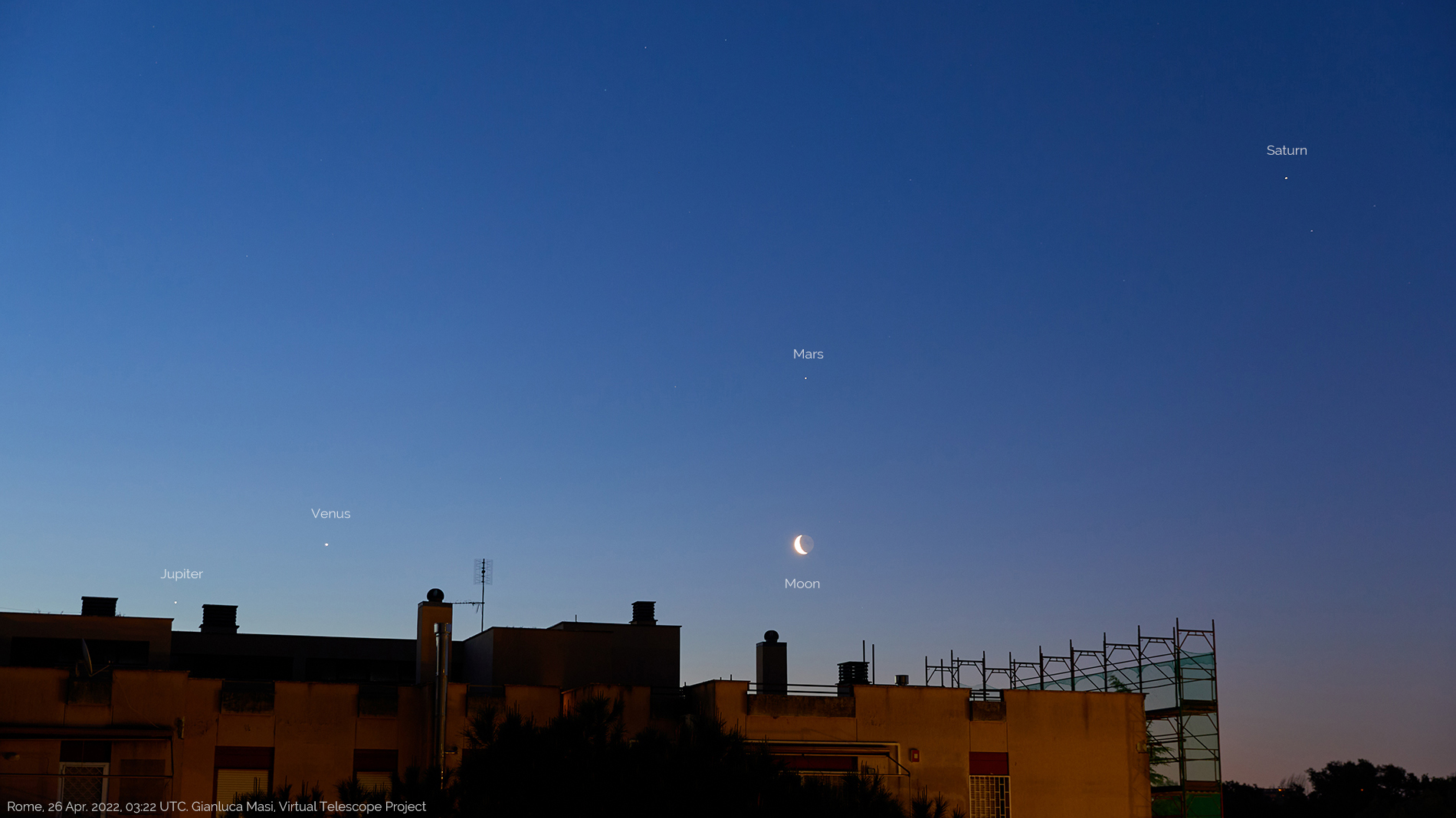4 planets line up like ducks in a row in gorgeous night-sky image
Astrophysicist captures the planetary parade.
The moon is leading a parade of planets across the predawn sky this week. And Italian astrophysicist Gianluca Masi captured the celestial show in a gorgeous image shot from his balcony in Rome.
In advance of an unusual alignment of the five visible planets in the solar system, four planets are lining up behind the moon like ducks in a row. Since April 23, Saturn, Mars, Venus and Jupiter have all been visible above the horizon in the early morning hours in the Northern Hemisphere.
"This morning I could enjoy the planetary parade involving Jupiter, Venus, Mars and Saturn, plus the moon. It was an amazing sight, all the four planets were very easy to see," Masi told Live Science in an email.
The night-sky photo is a precursor to a bigger planetary parade this summer, as Mercury will join the line-up in mid-June.
When the planets align
Planetary alignments occur when the planets' orbits bring them to the same region of the sky, when viewed from Earth. These planetary alignments are not rare, but they're not regularly occurring, either: The last time five planets aligned in the night sky was in 2020, preceded by alignments in 2016 and 2005.
These alignments take time to develop. Venus, Mars, and Saturn have been night-sky neighbors since late March. On April 4 and 5, they came so close together, when viewed from Earth, that Mars and Saturn appeared less far apart than the width of the full moon in the southeast early morning sky.
Related: Photos: Magnificent views of the nighttime heavens in America's 'Dark Sky' parks
Get the world’s most fascinating discoveries delivered straight to your inbox.

Jupiter turned the trio into a foursome in mid-April. Then the moon appeared in its last quarter phase to Saturn's right on April 23. Mars looks like an orange dot below and to the left of Saturn, while Venus is a brighter light below and to the left of Mars. Jupiter is the lowest and leftmost in the sky.
The way to tell the planets from the stars in the sky is by the light, said Michelle Nichols, the director of public observing at Chicago's Adler Planetarium.
"Stars twinkle," Nichols told Live Science. "Planets don't."
Watching the planetary alignment
The planets will be most visible in the northern hemisphere an hour to 45 minutes before sunrise. The moon will remain above the horizon until April 29, but the four planets will remain in their cosmic line until early July. Mercury will appear in the line as early as June 10 in places with a flat, eastern horizon (think Denver or the coast of North Carolina, looking out over the ocean), leading to the final five-planet alignment. The planets will appear to march from the east to the south, Nichols said. Late June will provide the best viewing conditions for the alignment.
Uranus and Neptune will also be in the field of view in the Northern Hemisphere during the alignment. Uranus will be between Mercury and Mars and will be visible in areas without much light pollution. It might be possible to see it with the naked eye in a dark-enough sky, but binoculars will aid in observing it, Nichols said. Neptune will require a telescope to view.
"It's just a great time to go out and see the planets," Nichols said.
Originally published on Live Science.
Editor's note: This article was first published on April 20, 2022, and updated on April 26.

Stephanie Pappas is a contributing writer for Live Science, covering topics ranging from geoscience to archaeology to the human brain and behavior. She was previously a senior writer for Live Science but is now a freelancer based in Denver, Colorado, and regularly contributes to Scientific American and The Monitor, the monthly magazine of the American Psychological Association. Stephanie received a bachelor's degree in psychology from the University of South Carolina and a graduate certificate in science communication from the University of California, Santa Cruz.



